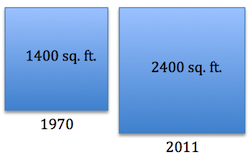One hallmark of the American dream has been owning a home. But over the years, the notion of a “dream home” has changed drastically.

According to US census data, the average American home of the 1950s was just 1,000 square feet. Today that square footage has more than doubled to about 2,500 square feet. Families have gotten smaller and everyday items streamlined or made portable. So, when it comes to houses, is bigger truly better?
Today that square footage has more than doubled to about 2,500 square feet. Families have gotten smaller and everyday items streamlined or made portable. So, when it comes to houses, is bigger truly better?
One could argue a smaller floor plan comes with many benefits. Here are a few benefits which illustrate less is more when it comes to your home:
Saving Money: Who doesn’t like to save money? Downsizing your dream home can mean a significant decrease in cost. A smaller home also means a smaller mortgage payment and lower taxes.
Less Cleaning: More space means more space to clean. Time, cleaning supplies and elbow grease aren’t a fantastic way to spend one’s free time. (Does anyone really like cleaning gutters?) A smaller house will cut down on cleaning time, providing time for more compelling activities.
Lower Maintenance Cost: Less space also means less maintenance. When it’s time for a new roof or new flooring, a small space will cause less sticker shock. Yards are generally smaller as well, so there’s less outdoor upkeep.
Heightened Consciousness of Clutter: Much like the size of a goldfish is limited by the size of its bowl, humans and their “stuff” are limited by their homes’ capacity. We are consumers, collectors and shoppers — sometimes it’s far too much. Having less space means hanging on to the things you really love or actually need. In essence, less space makes simplifying and organizing a must.
Reduced Environmental Footprint: A smaller home uses less resources, period. From the construction phase through the lifetime of the structure, it takes less energy and materials to maintain. This is particularly true if green materials (sustainable wood products, energy efficient appliances, continuous insulation) are used in building the home.
More Social Interaction: In a large house, everyone has their own space. That can be good at times, but often means family members retreat to their own turf and spend little time together..jpg?width=450&name=dreamstime_l_97791832%20(1).jpg) Less space encourages interaction and fosters relationships. For instance, if the kitchen and living room are larger and the hub of activity in the home but bedrooms are kept small, chances are your family will experience more togetherness. (C’mon, that’s not a bad thing!)
Less space encourages interaction and fosters relationships. For instance, if the kitchen and living room are larger and the hub of activity in the home but bedrooms are kept small, chances are your family will experience more togetherness. (C’mon, that’s not a bad thing!)
A smaller house also encourages more outdoor time. You might even get to know the neighbors beyond a quick wave when passing.
Easier Customization: Just because a house is small doesn’t mean it needs to be generic or “cookie cutter.” The savings on the basics of your home could allow for a few splurges like high-end flooring, granite countertops or that copper sink you’ve been eyeing.
Wider Market to Sell: A smaller, more affordable house appeals to a larger percentage of home buyers. For instance, a smaller house in an area with great schools, parks and other amenities becomes an option for those with a smaller budget while larger homes in the same neighborhood would be out of reach.
A large home may still be a dream for some, but a smaller home may be a wise and more flexible choice for those who want to save money and time. Less money spent on decorating, accumulating clutter and housing costs means more spare cash for other endeavors. Instead of spending time taking care of a house, you’ll have more time to enjoy a cozy home with family and friends.

Our Mission: Our Commitment
When you build with Enercept SIPs we provide a building that will go up faster and will be warmer, tighter, stronger, quieter and more cost-effective than conventional construction. It is a commitment that others simply can’t beat!











